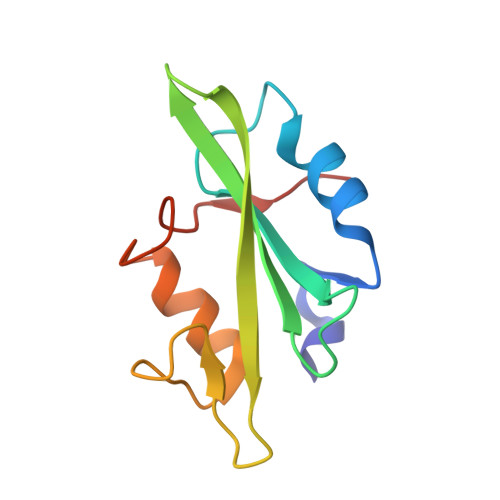Requirements for specific binding of low affinity inhibitor fragments to the SH2 domain of (pp60)Src are identical to those for high affinity binding of full length inhibitors.
Lange, G., Lesuisse, D., Deprez, P., Schoot, B., Loenze, P., Benard, D., Marquette, J.P., Broto, P., Sarubbi, E., Mandine, E.(2003) J Med Chem 46: 5184-5195
- PubMed: 14613321
- DOI: https://doi.org/10.1021/jm020970s
- Primary Citation of Related Structures:
1O41, 1O42, 1O43, 1O44, 1O45, 1O46, 1O47, 1O48, 1O49, 1O4A, 1O4B, 1O4C, 1O4D, 1O4E, 1O4F, 1O4G, 1O4H, 1O4I, 1O4J, 1O4K, 1O4L, 1O4M, 1O4N, 1O4O, 1O4P, 1O4Q, 1O4R - PubMed Abstract:
Results from a novel approach which uses protein crystallography for the screening of a low affinity inhibitor fragment library are analyzed by comparing the X-ray structures with bound fragments to the structures with the corresponding full length inhibitors. The screen for new phospho-tyrosine mimics binding to the SH2 domain of (pp60)src was initiated because of the limited cell penetration of phosphates. Fragments in our library typically had between 6 and 30 atoms and included compounds which had either millimolar activity in a Biacore assay or were suggested by the ab initio design program LUDI but had no measurable affinity. All identified fragments were located in the phospho-tyrosine pocket. The most promising fragments were successfully used to replace the phospho-tyrosine and resulted in novel nonpeptidic high affinity inhibitors. The significant diversity of successful fragments is reflected in the high flexibility of the phospho-tyrosine pocket. Comparison of the X-ray structures shows that the presence of the H-bond acceptors and not their relative position within the pharmacophore are essential for fragment binding and/or high affinity binding of full length inhibitors. The X-ray data show that the fragments are recognized by forming a complex H-bond network within the phospho-tyrosine pocket of SH2. No fragment structure was found in which this H-bond network was incomplete, and any uncompensated H-bond within the H-bond network leads to a significant decrease in the affinity of full length inhibitors. No correlation between affinity and fragment binding was found for these polar fragments and hence affinity-based screening would have overlooked some interesting starting points for inhibitor design. In contrast, we were unable to identify electron density for hydrophobic fragments, confirming that hydrophobic interactions are important for inhibitor affinity but of minor importance for ligand recognition. Our results suggest that a screening approach using protein crystallography is particularly useful to identify universal fragments for the conserved hydrophilic recognition sites found in target families such as SH2 domains, phosphatases, kinases, proteases, and esterases.
Organizational Affiliation:
Aventis Pharma, 102 route de Noisy, 93235 Romainville, France. [email protected]















